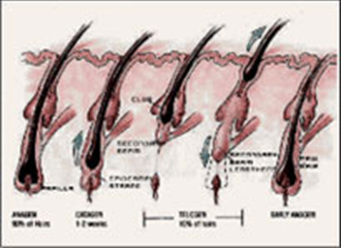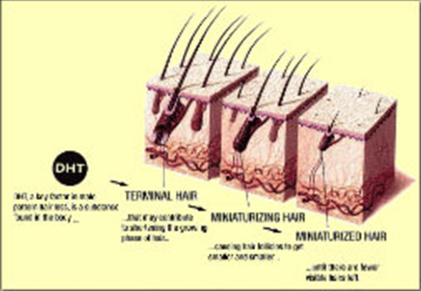|
| |
| Hair Grwoth |
| |
| Type of Hair |
 |
Adult has two types of hair. The typical hair on scalp that grows long and on an average, measures 65 to 75 microns (0.065 to 0.075 mm) in diameter (width) is terminal hair. We also have short, fine, light-colored hairs called vellus hair (Baby hair). At puberty, the increase in hormone levels (Testosterone) causes vellus hair in the pubic, armpit and male beard areas to grow deeper and longer and become terminal hairs. Terminal hair becomes villous hair in baldness |
 |
| Hair growth Cycle |
 |
 |
|
 |
 |
| For Scalp Hair |
 |
Stage of
Cycle |
Name of Phase |
What happens? |
Duration |
% of hair at
a given time |
| 1st |
Anagen
(Growing) |
New hair formation –lengthening and thickening of hair. |
2-6 years |
80-90% |
| 2nd |
Catagen (Intervening or Transition) |
Round |
2-3 weeks |
1% |
| 3rd |
Telogen (shedding-resting) |
Hair gets dislodged and shed either on its own while washing, brushing or by push of newly growing hair. |
2-3 months |
10 |
|
|
- Shedding 50 to 100 hairs a day is normal unless the hairs you're losing aren't being replaced by new ones. Progressive hair loss begins naturally in both sexes about age 50, accelerating in the 70s. About 40 percent of Caucasian men lose hair to some extent by age 35. When hair growth fails to keep up with hair loss, the result is thinning hair that can eventually lead to baldness.
- In some animals all the hairs are in the same phase at the same time and all the hairs go through regular, seasonal, growing and molting/shedding phases at the same time but in humans there is asynchronous growth i.e. not all hair shed together, because each hair has its own different independent growth cycle
- Body hair, eyebrow hair, eyelashes etc. all have shorter Anagen phases and longer Telogen phases so they don't grow as long as scalp hair.
- Usually the hair you see every day on you r brush or pillow, or in your shower or sink is the hair that is shed in the Telogen Phase. It will usually be replaced by a new, growing Anagen hair.
- In Androgenetic Alopecia (common Baldness), the commonest cause of permanent hair loss, the hormone, DHT, causes each generation of genetically sensitive hairs to have a shorter Anagen phase- called miniaturized hair. The affected hairs get progressively more fine and shorter and lighter in colour with each growth cycle until they finally don't grow back.
|
 |
 |
| Rate of growth |
 |
- Healthy scalp hair grows at an average daily rate of approximately 0.35mm(1/72 inch), 1 cm or < ½ inch a month that is, about 2.5cm(1 inch) every 21/2 months. Hair grows fastest in the summer, slowest in the winter, speeds up under heat and friction, but slows down when exposed to cold. Hair grows the best between the ages of 15 to 30.
- Pubic and axillary (armpit) hair is particularly androgen-sensitive and grows at lower androgen levels than hair on the chest or legs. In boys, most pubic hair is grown by age 15, followed by the development of armpit hair two to three years later. In girls, too, an increase in androgens at puberty triggers growth of pubic and armpit hair. Scalp hair, not directly androgen-responsive, is influenced by local amounts of a testosterone derivative, 5-Di Hydro Testosterone (5 DHT).
|
 |
| Follicular Unit (Hair Bundle): |
 |
Most people believe that hair grows in single strands very closely together. It doesn't. A magnified look at scalp hair that has been trimmed to 1 – 2 mm long will show that, in fact, hair grows in small "bundles" of 1,2,3, occasionally 4, hairs per "bundle". These hairs, along with their accompanying support system (sebaceous glands, erector pilae muscle etc.) form what is now known as the "Follicular Unit" . These 1-4 hair "bundles" usually exit the scalp through just a single pore! When examined under a microscope, these "Follicular Units" are clearly distinct anatomical entities, “individually wrapped” by a layer of (connective) tissue. These are believed to be nature's own building blocks.
FUT (Follicular Unit Transplant) is the precise dissection of each Follicular Unit, keeping all of its elements intact. This ensures optimal survival and growth of the hair and properly transplanted follicular units are indistinguishable from naturally occurring follicular units. Using nature's own building blocks for hair transplantation with follicular unit hair transplantation provides reliably good, natural results. |
 |
 |
| Hair Mass: |
 |
The fullness of our scalp hair depends on many factors. |
- Number (Density), Every adult human is born with about 100,000 to 150,000 scalp hairs follicles. The number of follicles will never increase. In fact, the number normally decreases to about one half that number by the age of 60. Fine and transparent, human body hair is a vestige of our hairier animal forebears like chimp although the number of hair over the body did not reduce.
- Thickness (Diameter or caliber) & length (Fine and transparent, human body hair is a vestige of our hairier animal forbears like chimp although the number of hair over the body did not reduce. This showed more skin of human. This is similar to the situation where number of hair implanted in scalp is not enough to give volume thickness and length is equally important. Thicker the hair longer the hair better the coverage.). Longer the hair covers more bald area.
- Curl: More the curl of the hair the better the scalp coverage e.g. curly less number of scalp in Negroid give better coverage than the straight more number of hair in Caucasian.
- Direction: More the acuteness of the angle of hair growth the more is the coverage.
- Colour: More the contrast between colours of the scalp skin and the overlying hair the more difficult to achieve the scalp coverage by hair restoration.
- Wet or Oily Hair: are more likely to show up baldness
- Light: More the direct bright light more the
|
 |
| Change of Hair cycle in Androgenetic Alopecia: |
 |
Hair cycle shortens gradually form 6 years to 3 years and then may be 1 year and then few months and before the hair stops producing hair. So the hair does not grow as long and thick as it used to. With shortening cycle the hair turn over increases so hair enters teleogen phase earlier and there may be increased hair fall. |
 |
| |
|